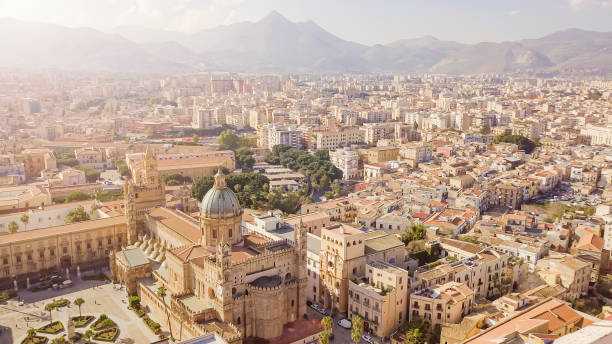Palermo
Palermo takes its name from the Greek Πάνορμος, the Romans changed it into Pánormos
Also known as Balarm , from the Arabs. It is the capital city of the Island of Sicily. Palermo is a an attractive city for its history, culture, architecture and food. It is situated in the north east part of the island and it is nearly 3000 years old.
It is on the sea and surrounded by a beautiful gulf (the Gulf of Palermo).The city was founded by the Phoenicians in 734 BC and after several dominations (Romans, Arabs, Greeks, Normans) it became the capital of the new Kingdom of Sicily (from 1130 to 1816).
Its Mediterranean climate, its legendary variety of food, wines and colorful street markets (Vucciria, Ballarò and Capo) along with the selection of different churches (Romanesque, Gothic, Baroque and Art Nouveau) make Palermo a great attraction. There is an international airport and a number of UNESCO World Heritage Sites. Santa Rosalia is the patron Saint of Palermo and it is celebrated on 15 July every year with a three-day festival.
Eating and Drinking
Food is one of the best attractions all over the island, Palermo is the city that offers the most numerous variety. Eating and drinking in town is a real pleasure, as the number of things to taste are all over the place. You cannot miss the ‘brios con gelato’ (ice cream sandwhich), Panino con le panelle (chick peas sandwich), the list of street food is too long to be listed. In addition there are restaurants and cafes for all budgets and tastes.
Must see:
The Norman Palace (Palazzo dei Normanni) which hosts the Cappella Palatina inside
The Zisa Castle (Palazzo della Zisa), once Kings residence and today the Islamic museum
Palazzo Abbatellis, in the 15th it was the residence to the prefect of the city, today it host the painting gallery
The Archeological Museum Antonio Salina, with remains from the Etrusca, Carthaginian, Roman and Greek cultures.
The Cathedral (Cattedrale), presents a mix of architectural styles.
San Giovanni degli Eremiti, with iter ed domes represents the typical Arab influence.
Chiesa della Martorana and the bell tower and Byzantine mosaics.
San Cataldo, of Norman architecture
San Domenico, so called the ‘The Pantheon pf illustrious Sicilians’
Santa Maria della Catena, so called because in the past the walls used to have chains.
Santa Maria dello Spasimo, it was built as a church but then transformed into a hospital. Today it is used as a concert hall.

Cappella Palatina
Where to stay
Palermo offers a number of accommodations for all budgets and preferences, from five star hotels to Holiday homes and Guest houses, as well as Bed and Breakfasts.
How to Get Around
If you want to be on your own, public transportation is not the best in Palermo and in the island in general. The best way is getting around by car with a driver to reach sites that are located out of the city, or on foot if you are in the city center. Towns are connected with busses and coaches.
Share this tour



